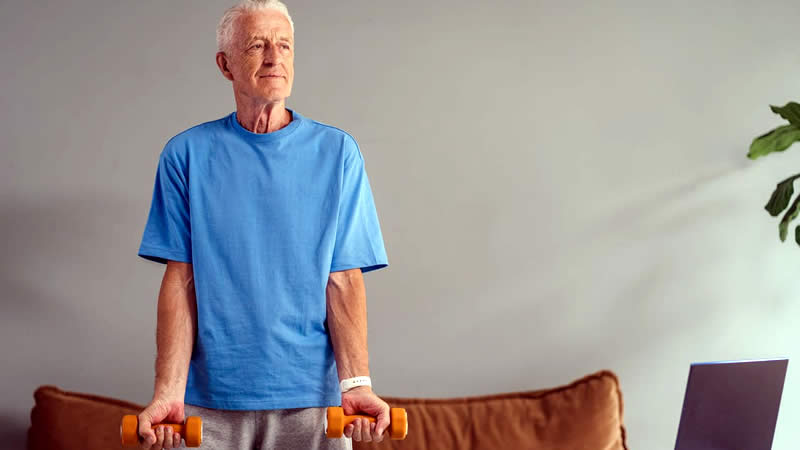You frequently hear from time to time, and more so after recovering from a recent health crisis, about the importance of being healthy and the consequences of poor health.
Indeed, neglecting your well-being turns your body into the breeding ground for illnesses and injuries.
Results are not merely achieved with words; actions lead to fruitful outcomes. It is especially true when keeping a check and balance on overall health.
One of the crucial aspects of staying healthy is being physically fit, whether young or old.
Why is that? It is so because physical fitness contributes to strong bones and muscles, enhances well-being, and prevents the risk of health problems.
Some might say that a healthy diet is a key to fitness or adequate sleep, whereas other emphasize how sleep or diet have no impact on your health unless some form of exercise is incorporated into your daily routine.
The truth is that all three factors play a critical role in maintaining health regardless of age. We often hear how the elders are at increased risk of suffering from health issues; this happens when seniors are not concerned about their health.
Besides taking measures, seniors neglect their health by not going for regular check-ups leading to dire consequences.
For instance, people who work in construction are exposed to toxic materials like asbestos that have adverse effects, eventually causing mesothelioma, which is diagnosed later in life.
It is untreatable in most cases due to the inability to detect symptoms which include shortness of breath and chest pain, among the most common symptoms.
Besides consulting a doctor or covering the expensive treatment costs with mesothelioma trust funds, specific lifestyle changes are a few ways to extend life.
Nobody knows their expiration date, especially after crossing 50; instead of waiting and watching as life goes by, working on staying fit is the best way to make every day count.
A few fitness tips are mentioned to help those entering the advanced phase of life.
1. Strength training
Many are unaware of the fact that where bones become weak, muscle mass also declines with age. Strength training, in such circumstances, is the key to preventing loss of muscle mass.
Though the idea of lifting weights in the golden years might seem intimidating for many, it has numerous benefits aside from increasing muscle mass, which is strong bones, enhanced joint flexibility, and improved balance.
Another common misconception about weight training is that you must be huge to head to the weight room. You can start by lifting light weights.
However, before jumping on to an exercise routine, those above 50 need to seek a doctor’s consultation to discuss any underlying conditions like degenerative disorders or high blood pressure that might aggravate through exercise.
For any exercise, it is crucial to have a proper form; it is recommended that older adults work with a personal trainer to avoid doing too much on the first day and learn good form.
Some of the best strength training tools include resistance bands to build muscle mass and strength training machines like leg presses that help you establish proper form.
Experts recommend starting with 20 minutes and then getting it up to 30 or 45 minutes as strength develops.
2. Water Aerobics
Arthritis and joint pain are common complaints of senior citizens that prevent them from participating in physical activity.
However, water aerobics is an effective tool in relieving joint stress and pain due to water buoyancy properties, unlike other forms of exercise.
Besides relieving stress, water also acts as a resistance, which means strength training and water aerobics are alike.
An important reminder is to ensure that safety measures are in place and always perform these exercises under supervision. Begin with aqua jogging which gets your heart pumping.
Aqua jogging is also performed with variations like jogging from one end of the pool or simply marching in place; the goal is to get your body temperature up. Another low-impact cardio exercise is flutter kicking.
Flutter kicking is performed with or without using a kickboard. While using one, keep it steady in front as you move your legs back and forth.
Older adults can perform standing water push-ups that strengthen the arms, chest, and shoulder. Keep the repetitions and intensity within the limit.
3. Yoga
Yoga is beneficial for those not keen on participating in physical activity regularly. Though Yoga increases the body’s flexibility, it helps clear the mind, which is crucial for maintaining overall health.
In old age, Yoga is more than just getting into shape; it’s about attuning to the energy flowing through your body and seeking inner peace. Yoga is an escape to reconnect with yourself and stay healthy in a world full of chaos.
The practice incorporates breathing exercises that rid the mind of unnecessary thoughts and boost oxygen levels which ultimately lead to feelings of calm and relieve stress.
Unlike cycling or running, Yoga does not increase heart rate but improves cardiovascular function through increased oxygen levels.
Some yoga poses that adults over 50 can practice include chair and tree pose. Yoga is specifically beneficial for individuals combating lung disease, as the cobra pose opens up the chest encouraging deep breathing and increasing lung capacity.
4. Hiking
The physical activity you participate in depends on your fitness goals and their overall impact on your mood.
For older adults who seek mental clarity and enjoy the outdoors, hiking is the most suitable physical activity.
Contrary to popular belief, aging is not the only critical factor to weakness; it is, in fact, the sedentary lifestyle that contributes to a person’s deteriorating health.
Though turning the clock might not be in your hands but slowing it down is; that being said, it is never late to start working on yourself.
You don’t need to choose a challenging trail for a hike; walk around the neighborhood to get a feel.
Some benefits of hiking aside from uplifting mood include reduced blood pressure, decreased risk of falls or injuries, minimized pain associated with arthritis, and maintaining healthy bones and muscles.
However, before heading out, always keep in mind a few tips to make the experience less challenging. For instance, if it’s your first time going on a hike, make sure you get cleared for exercise by your doctor.
Always take it slow; start with a daily walk and prolong it to a hike. Since hydration helps keep up with any level of exercise, don’t forget to pack extra water bottles.
Conclusion
Though reversing the time might not be in our hands, slowing it down is. That is only possible when we take our health seriously, especially after crossing 50. In old age, being physically fit is the only solution to preventing illnesses or reducing the risk of falls.
Physical fitness usually starts with taking it one day at a time and making lifestyle changes that have a lifelong impact.
Creating an exercise routine can start with going for a walk daily or participating in several physical activities like Yoga, hiking, or water aerobics.



